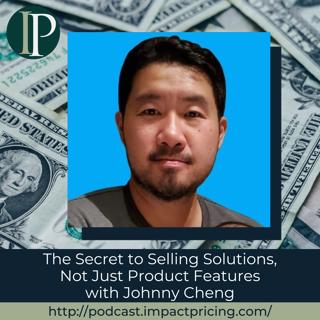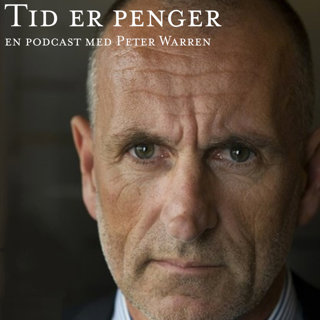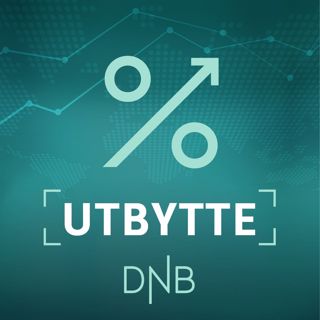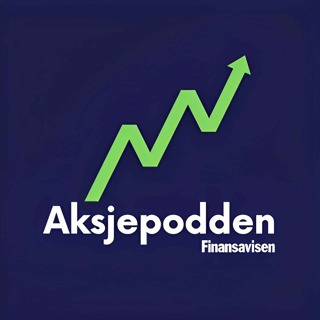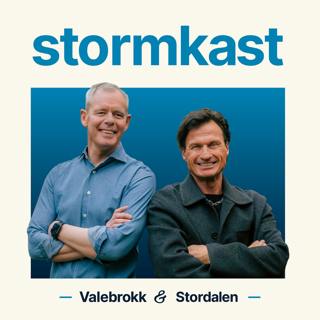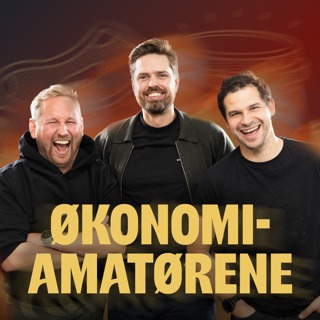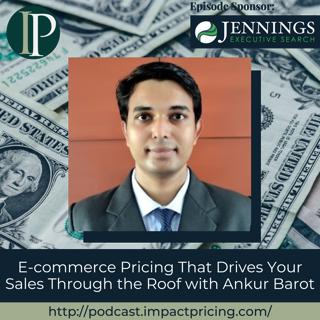
E-commerce Pricing That Drives Your Sales Through the Roof with Ankur Barot
Ankur Barot started his career in engineering and soon transitioned to business. Currently, he is an e-commerce expert and is working as the manager of strategic initiatives at BigBasket, one of the biggest online grocery platforms in India. In this episode, Ankur talks to us about the important strategies when it comes to pricing in the world of e-commerce. He shares valuable tips on how to make customers choose your platform over your competitors’, and how to charge different prices on different customers depending on their buying behavior and your competitors’ prices. Why you have to check out today’s podcast: Find out the factors to consider in pricing your products in the online market Learn how to make customers choose your platform over your competitors’ platforms Discover how to charge different prices on different customers by monitoring their buying behavior and your competitors’ prices “In pricing, it is definitely very important considering how your costs are aligned and how the competitive prices align. A large part is also on how you are communicating the price to customers.” – Ankur Barot Topics Covered: 01:32 – How Ankur got into pricing 02:17 – The work that BigBasket does, and what makes it unique 04:29 – COVID gave the companies that did delivery a chance to explode in growth 05:54 – Ability to shop in stores again did not stop customers from ordering online 06:39 – COVID was almost like a forced trial where people had to order online; and they found it to be easier and more convenient 08:11 – Promotions and other factors that determine whether customers will place an order on your platform or not 11:21 – How to get customers to order on your platform instead of your competitor’s platform 16:12 – Analyze how much your customers are willing to pay for a product; Make sure the customers would get what they want even right before the billing process 20:05 – How to charge different prices to different customers by monitoring their buying behavior as well as the competitors’ prices 23:29 – How companies in India find the prices of their competitors’ products 27:02 – Ankur’s pricing advice 29:36 – Connect with Ankur Key Takeaways: “We learned that pricing plus the stock availability as well as assortment, as well as how you are charging the convenience fee – all these aspects will decide whether the customer is placing an order on your platform or not.” – Ankur Barot “It is not about only the product pricing that the e-commerce portal has, it is what other parts of the chain that will bring in a customer and place an order on your platform.” – Ankur Barot “At the back end, what the company or what we are trying to do is select our key value items that the customer will remember the prices for, and we’ll definitely build a long-term perspective that they are the cheapest among all the competitors.” – Ankur Barot People / Resources Mentioned: BigBasket: https://www.bigbasket.com/ Connect with Ankur Barot: LinkedIn: https://www.linkedin.com/in/ankurbarot/ Email: ankurbarot19@gmail.com Connect with Mark Stiving: LinkedIn: https://www.linkedin.com/in/stiving/ Email: mailto:mark@impactpricing.com
5 Des 202230min

Blogcast #83: More Lessons from Netflix
This is an Impact Pricing Blog published on October 26, 2022, turned into an audio podcast so you can listen on the go. Read Full Article Here: https://impactpricing.com/blog/more-lessons-from-netflix/ If you have any feedback, definitely send it. You can reach us at mark@impactpricing.com. Now, go make an impact. Connect with Mark Stiving: Email: mark@impactpricing.com LinkedIn: https://www.linkedin.com/in/stiving/
2 Des 20222min
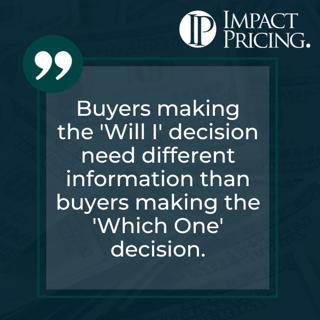
Pricing Table Topics #85: Jack of Hearts: 'Will I' Decision Needs Different Information than 'Which One’ Decision
This is the Jack of Hearts from the Selling Value card deck. It's true, buyers making the 'will I' decision do need different information than those making the 'which one' decision. In the 'will I' decision, they're trying to decide, should I buy something in this product category or not? What they're really saying is, is this a place I should spend my budget? Or you could think of this as, how big is the problem I'm going to solve, should I spend these resources to go solve this problem? And that's the information they want to know is, what's the value of solving this problem? Once they've said, yes, that seems like a good place to spend my money. Then they move on to making a 'which one' decision. Should I buy your product or should I buy a competitor's product? When they're making this 'which one' decision, they're now looking at the differences of the products, the features, and in fact, they're trying to estimate how much value is that feature for that one more expensive product. I often like to think what they're really asking is, is the more expensive product worth it? So, when buyers are making the 'which one' decision, they're actually looking at the differentiation of our products. So, it's true, buyers making the 'will I' decision do need different information than buyers making the 'which one' decision. We hope you enjoyed this example of Pricing Table Topics. If you want to get better at speaking, specifically about pricing and value, grab a deck of our cards, pull a random card, read the saying, and then talk for one to two minutes about what that card says. If you have any questions or feedback, please email me, mark@impactpricing.com. Now, go make an impact. Connect with Mark Stiving: Email: mark@impactpricing.com LinkedIn: https://www.linkedin.com/in/stiving/
30 Nov 20222min
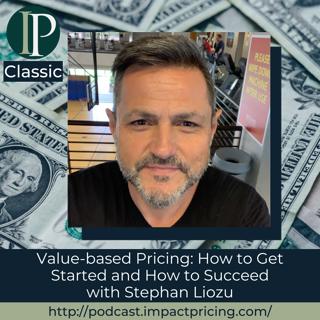
#CLASSIC Value-based Pricing: How to Get Started and How to Succeed with Stephan Liozu
Stephan Liozu is the Founder of Value Innoruption Advisors, a boutique consulting firm specializing in disruptive approaches in value, pricing, and strategic management. He helps leaders in organizations that want to get started in pricing by conducting assessments and building road maps. In this episode, learn all about value pricing and how to use the right pricing toolbox to come up with a price based on how much a customer believes a product is worth. Why you have to check out today’s podcast: Discover why value-based pricing is the most neglected step in understanding price Learn how to communicate product value in value conversations with customers before products are made for better pricing Find out the importance of having a pricing strategy to determine a product’s value “Critical problems are around value. Pricing comes later.” – Stephan Liozu Topics Covered: 01:01 - How Stephan got into Pricing: having been named ACP deployment officer for Owens Corning Europe taking care of the pricing module in SAP 02:37 - The role of a chief value officer: Being the chief conductor of all the value and pricing activity in an organization. 05:50 - The whole process of measuring value, creating, and capturing it using the dollarization methodology 07:39 - Going through value creation: looking at the customer problem, do a better job of understanding the customer problem, uncovering it through market research, insights, and ethnographic research 09:14 - ‘99% of businesses are there to create value, oftentimes they don't know what value really means.’ Stephan's thoughts on it. 13:40 - Conversations put your customers at ease. Stephan's perspective about value conversation and the challenge that goes with it. 16:30 - Why do companies don't understand what product value is? Stephan states the three reasons why. 17:58 - Why is it important to ask the right questions? 19:18 - Customer segmentation is an often-neglected part of a value conversation. Another reason why companies don't think about value. 19:54 - What Stephan is up to these days: leveraging technology to a lot of his work focusing on monetization of software and data. 21:03 - Hardware product companies are giving away the software as a way to sell their hardware. We hear Stephan's idea about it. 22:32 - Talking about cost and value in SaaS companies. The challenge of communicating the value of its product. 24:49 - He couldn't care less about focusing more on the value of a product. His one pricing advice that could impact your business. Key Takeaways: “Our competitors are also looking at the customer problem. So, we got to do a better job at understanding the customer problem, uncovering it through market research, insights, ethnographic research.” - Stephan Liozu “I wanted not to be a CPO chief pricing officer, I wanted to be a CVO chief value officer, because our critical problems are around value, you know, pricing comes later.” - Stephan Liozu “Psychologically it puts your customers at ease when you have a conversation, whether it's in creation mode, in quantification, validation, and communication.” - Stephan Liozu “To be doing the work in value, you have to have value conversations.” - Stephan Liozu “If we have to continue doing everything in finance around the product, then we're not going to achieve our goal to show the value of everything else we do in the bundle.” - Stephan Liozu People / Resources Mentioned: Ron Baker: https://impactpricing.com/podcast/ep44-ronald-j-baker-trash-the-timesheet-exploring-opportunities-in-subscription-businesses/ Connect with Stephan Liozu: LinkedIn: https://www.linkedin.com/in/stephanliozu/ Website: http://stephanliozu.com/ Connect with Mark Stiving: LinkedIn: https://www.linkedin.com/in/stiving/ Email: mailto:mark@impactpricing.com
28 Nov 202226min
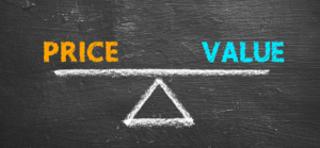
Blogcast #82: Value and Price for a Few Customers
This is an Impact Pricing Blog published on October 19, 2022, turned into an audio podcast so you can listen on the go. Read Full Article Here: https://impactpricing.com/blog/value-and-price-for-a-few-customers/ If you have any feedback, definitely send it. You can reach us at mark@impactpricing.com. Now, go make an impact. Connect with Mark Stiving: Email: mark@impactpricing.com LinkedIn: https://www.linkedin.com/in/stiving/
25 Nov 20223min
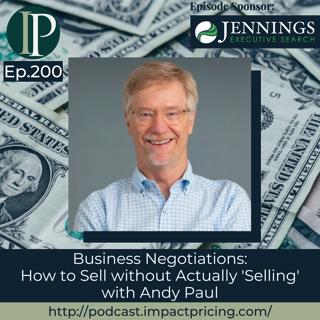
Business Negotiations: How to Sell without Actually 'Selling' with Andy Paul
Andy Paul is the author of Sell Without Selling Out. He's the host of the Sales Enablement Podcast, and has experience on being VP of Business Development and VP of Sales. In this episode, Andy talks about the importance of the “human element” and why we should utilize it more when it comes to business negotiations Why you have to check out today’s podcast: Learn how automated business sequences negatively affects your business Understand the importance of having the “human element” in business negotiations Find out why you should hire actual negotiation experts and not salespeople when it comes to price negotiations “Managers, take responsibility. Don't put the discounting in the hands of the sellers. And if managers show a little more discipline, then they can preserve the margins better.” – Andy Paul Topics Covered: 02:35 – The time Andy learned that pricing is important in the world of sales 06:02 – Selling is about listening to your customers and finding ways to help them 08:37 – How you should communicate value to a customer to make a successful sales meeting 13:28 – Making your customers feel understood is one step in winning sales 17:07 – Why salespeople are unable to utilize the human element 19:20 – Automated selling sequences is mostly persuasive, which is not the best way to go in sales 20:50 – Salespeople’s job is to build one on one relationships with customers, as all customers are not the same 22:30 – How salespeople should handle price segmentations or price negotiations 25:25 – Have professional contract negotiators handle negotiations, and you’ll end up getting better deals 29:11 – Andy’s pricing advice Key Takeaways: “I say sales, what you have to think about is your job as a salesperson is really nothing more than listening to your buyer, understanding the things that are most important to them in terms of the challenges they face and the outcomes they want to achieve by addressing those challenges and then helping them get that. That's your job. Listen and help.” – Andy Paul “If you can be the first to make the buyer feel understood, there are serious milestones happening that you can actually put yourself in the pole position, and win the deal at a higher frequency than your competitors.” – Andy Paul “When humanity becomes the differentiator and all the automated buying experiences start to become more similar, how do you stand apart? Being human.” – Andy Paul “Everyone wants to point the finger at salespeople as to be the blame for discounting. And the fault is really managers. It's not salespeople.” – Andy Paul People / Resources Mentioned: How to Sell Without Selling out: https://www.amazon.com/Sell-Without-Selling-Out-Success/dp/1989603572 Humans are Underrated: https://www.amazon.com/Humans-Are-Underrated-Achievers-Brilliant/dp/0143108379 Talent is Overrated: https://www.amazon.com/Talent-Overrated-Separates-World-Class-Performers/dp/1591842948 Geoffrey Colvin: https://geoffcolvin.com/ Toastmasters: https://www.toastmasters.org/ Connect with Andy Paul: LinkedIn: https://www.linkedin.com/in/realandypaul/ Website: https://www.andypaul.com/ Connect with Mark Stiving: LinkedIn: https://www.linkedin.com/in/stiving/ Email: mailto:mark@impactpricing.com
21 Nov 202233min
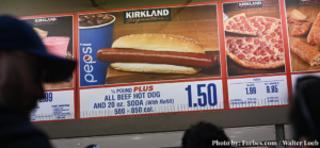
Blogcast #81: The Strategic Hot Dog
This is an Impact Pricing Blog published on October 12, 2022, turned into an audio podcast so you can listen on the go. Read Full Article Here: https://impactpricing.com/blog/the-strategic-hot-dog/ If you have any feedback, definitely send it. You can reach us at mark@impactpricing.com. Now, go make an impact. Connect with Mark Stiving: Email: mark@impactpricing.com LinkedIn: https://www.linkedin.com/in/stiving/
18 Nov 20222min
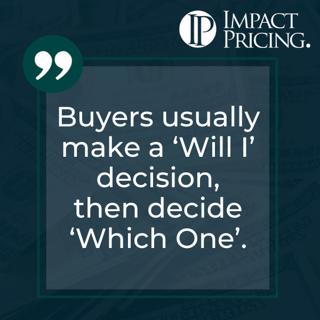
Memecast #84: Jack of Spades: Will I, then Which One
This one is the Jack of Spades from the Selling Value card deck. Buyers usually make a 'will I' decision, then decide 'which one'. They make the 'will I' decision, meaning, am I going to buy something in the product category? Am I going to buy a new car? Am I going to buy a new guitar? Am I going to buy a new refrigerator? Am I going to go out to dinner tonight? Am I going to hire a consultant? We make this 'will I' decision, and then after we've said, yes, I need a - you pick it - I need to hire a consultant, then we decide 'which one'. We interview several different consultants. We get bids from them. We see which ones we get along with. But then we're making that ‘which one’ decision. And it's very important for our sales people, our marketing people, even our product people, to understand the difference between these two questions because when buyers are making these two decisions, they're using different information and they care about different things. Oh, and from my perspective, the price sensitivity changes dramatically and they become much more price sensitive when they move to the 'which one' decision. We hope you enjoyed this memecast. This is also an example of how Pricing Table Topics works. Grab a deck of our cards, pull a random card, read the saying, then talk for one to two minutes about what that card says. This will improve your understanding and more importantly, your ability to communicate important concepts about value. If you have any questions or feedback, please email me mark@impactpricing.com. Now, go make an impact. Connect with Mark Stiving: Email: mark@impactpricing.com LinkedIn: https://www.linkedin.com/in/stiving/
16 Nov 20222min
